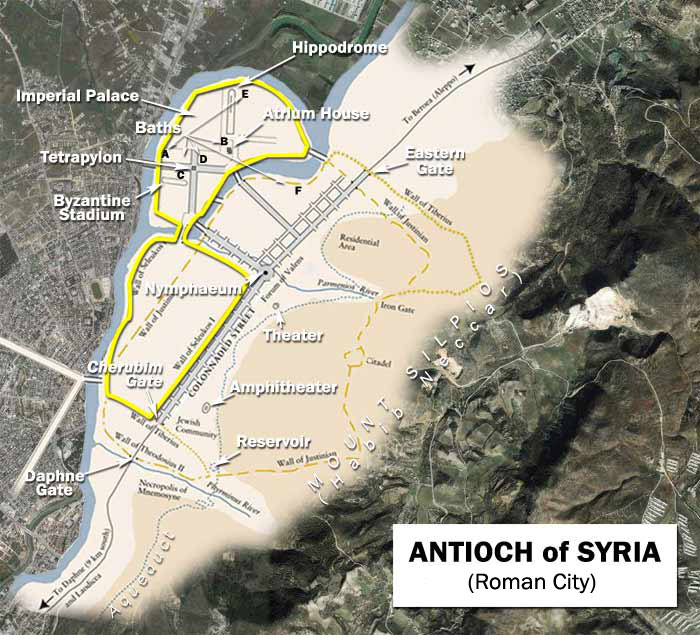
Many locations only approxmiate.
Click within yellow outline to see plan of the original Hellenistic city.
Modern city Hellenistic Antioch
Zoom out to Asia Minor satellite view
Zoom way out to “Lands of the Eastern Mediterranean”
Paul’s First Missionary Journey
Paul’s Second Missionary Journey
Paul’s Third Missionary Journey
As the capital of the Roman province of Syria in the first century CE, Antioch-on-the-Orontes, also known as Antioch of Syria, was the third largest city of the Roman Empire (after Rome and Alexandria) with a population perhaps as high as 500,000.
Antioch was the first place where Christianity confronted a truly urban environment, and large numbers of converts to Christianity came from Gentiles. It was the first place where Christ’s disciples were called “Christians” (Acts 11:26, see vv. 19-30). A few years later, Syrian Antioch became the sponsoring church for Paul’s missionary journeys, first with Barnabas and then with Silas (Acts 13:1-3; 14:26-28; 18:21-23).
On Peter’s visit to Antioch, the issue of table fellowship between Jewish and Gentile Christians came to a head (see Galatians 2:11-21). At first, Peter freely associated with the Gentile believers but drew back when certain brothers from Jerusalem arrived. Paul was compelled to rebuke Peter in front of everyone to preserve the truth of the gospel. It is disputed whether this incident happened before or after the Jerusalem conference of Acts 15. I believe it makes more sense if it took place prior to the conference, which would make it just after Paul returned from the First Missionary Journey.
Beginning during the reign of Tiberius (who ruled 14 to 37 CE), the Romans expanded the walls around Antioch. The most extensive of these wall-building projects was that of Justinian I (Eastern emperor from 527-565 CE), whose engineers took their walls right up the steep sides of Mount Silpius and across its chasms.
Not much is left to see of ancient Antioch. If you visit the city, be sure to spend many hours at the archaeological museum, which has one of the best collections of ancient mosaics in the world. You will also want to visit the Grotto of St. Peter (S. Pierre), a cave believed by many to be the oldest Christian church in the world.
Want to dive deeper?
The following are recommended to help you look deeper into the history and archaeology of Antioch of Syria.
Recommended for purchase

Jerome Crowe – From Jerusalem to Antioch: The Gospel Across Cultures (Liturgical Press, 1997) – What happens when the gospel is carried from one world to another and a Christian community is born in a new culture? How does the dynamism of gospel reshape the culture that accepts it? How does that culture enrich the gospel with new ways of self-expression? This book explains what happened when Jewish missioners carried the Gospel from the Jewish world of Jerusalem into the Hellenistic world of Antioch to found the first “Christian” community. It presents the results of modern research on the church of Jerusalem and the church of Antioch.
Hatay Muzesi – Hatay Museum and Environs (1991)
Claude E. Fant & Mitchell G. Reddish – A Guide to Biblical Sites in Greece and Turkey (Oxford, 2003). Excerpt
Christine Kondoleon – Antioch: The Lost Ancient City (Princeton, 2000) – This lavish exhibition catalog brings to life Antioch. Featuring 118 objects excavated from the city’s ruins, all reproduced in full color. Displays and describes the excavated artifacts–mosaics, sculpture, glass, metalwork, coins–within their architectural and cultural contexts, thereby evoking the street life as well as the domestic lives of Antioch’s citizens.
For online reading
Edmond S. Bouchier – A Short History of Antioch: 300 B.C. – A.D. 1268 (Oxford: Basil Blackwell, 1921) – try the flip book version.
Sacred Destinations – “Antioch (Antakya)” – many pages, all excellent.
Christopher Ecclestone – “Antiochepedia” – This is perhaps the most complete site dedicated to the study of ancient Antioch of Syria. It has a wealth of material for understanding the ancient city and its archaeology and contains a helpful bibliography. CAUTION: This site is very slow in opening and refreshing.
Troels Myrup Kristensen. The Archaeology of Antioch, Part I and Part II – Kristensen is a post-graduate classical archaeology student at a university in Denmark, involved in an ongoing project: “Art & Social Identities in Late Antiquity.”
Dick Osseman’s excellent photos of Antakya-Hatay, the St. Peter’s Grotto, and the Archaeological Museum’s fabulous collection of ancient mosaics and other objects.
